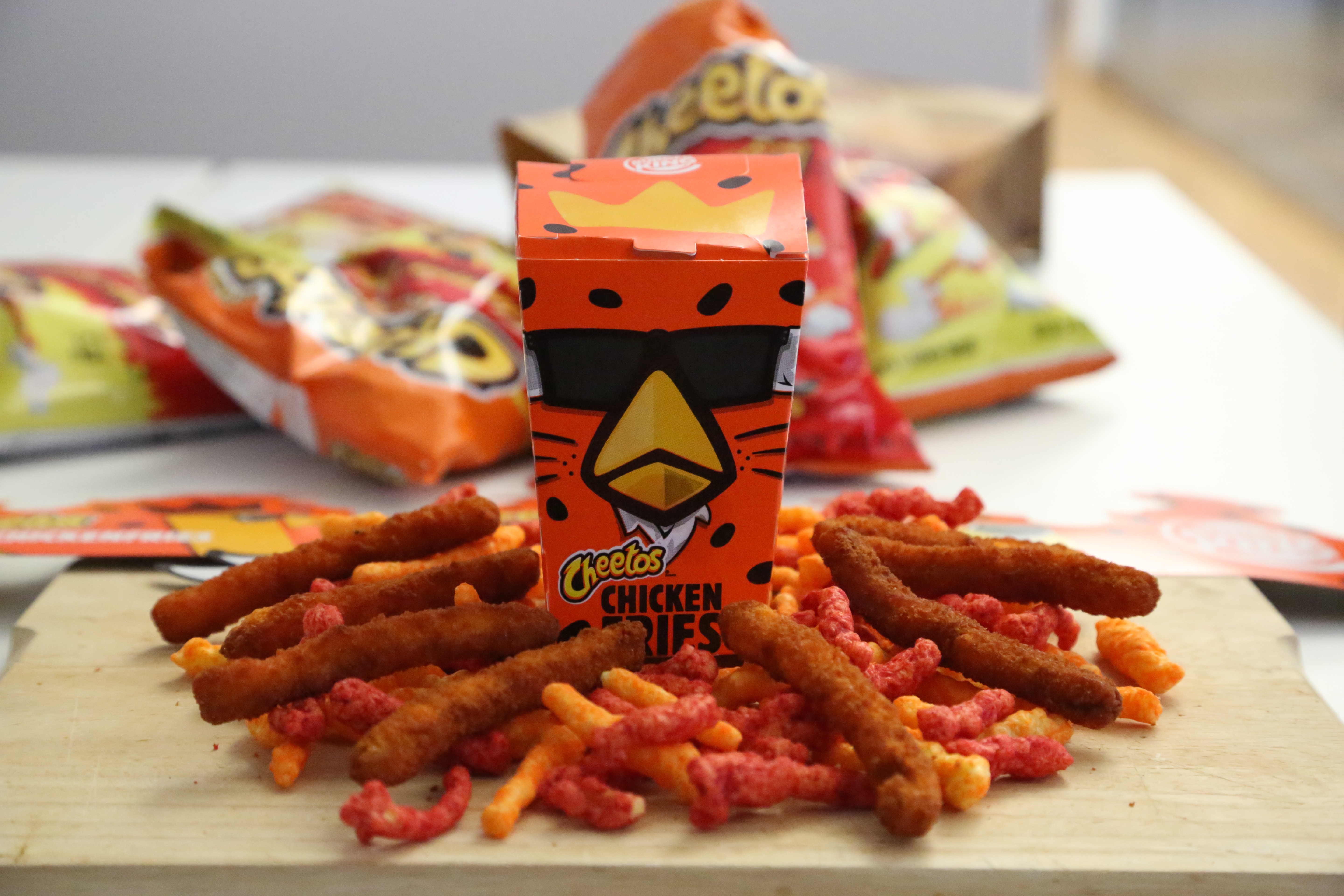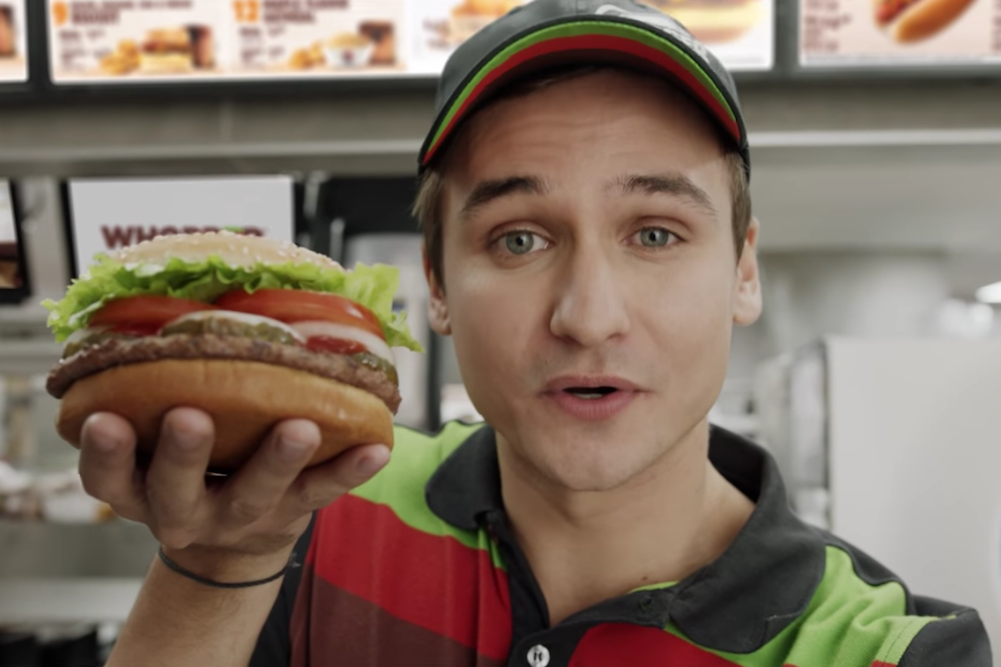I try to eat well, but I’m only American. Years of living amongst advertising has chipped away my brain’s natural defenses; any well-edited, brightly colored commercial, wherein a waterfall of onion rings or something similarly golden, slowly cascades over the screen will lead me to go, “Hey, why not?” Human curiosity and manufactured hype leads one to Mountain Dew Pitch Black, Taco Bell Sriracha Quesarito, Wendy’s Ghost Pepper Fries. Life is too short to not transgress culinary norms—to not indulge your inner Guy Fieri every once in awhile.
So, naturally, I’m in a Burger King. For a few years, the burger franchise has been stretching its menu in zanier, even more unnatural directions. They chopped up the iconic Whopper and served it as a burrito; they started grilling hot dogs, branding them as “Classic” despite first going on sale in March 2016. They sold Doritos Loaded Bites™, a triangle of cheddar deep-fried in Doritos-flavored breading. They sold Mac and Cheetos™, ooey-gooey mac n’ cheese deep-fried in Cheetos-flavored breading. And now, they’re selling the Cheetos Chicken Fries™, thin strips of presumably white meat deep-fried in—guess what—Cheetos-flavored breading.
Cross-brand synergy isn’t a 21st century concept; figurines of Mickey Mouse and the Ninja Turtles have popped up in McDonald’s Happy Meals for decades. But the revolution really began in 2012, when Taco Bell launched the Doritos Loco Taco, a product of three years of relentless engineering and product testing. “Nobody had ever done this before: turning a Dorito into a taco shell,” then-marketing director Stephanie Perdue told Fast Company. “It was just mind-blowing at the idea stage.”
The idea was ripped from a stoner daydream: What if the taco shell tasted like Doritos, bruh? But the Doritos tacos, initially available in Nacho Cheese and Cool Ranch flavoring, sold outrageously: 100 million dispensed within 10 weeks, 600 million after 17 months. Taco Bell’s sales shot up, as did the stock of their parent company, YUM! Brands. Taco Bell unveiled more flavored shells; Doritos unveiled the Doritos Loco Taco-flavored Dorito, a capitalist Ouroboros if there ever was one. “Only Taco Bell and Frito-Lay could partner together to create the hugely successful DLT platform,” a Taco Bell flack bragged in a press release.
The blueprint for the future was set; now, it’s impossible to imagine a Taco Bell menu sans Doritos. The business end was sound, though depressing if you envisioned a national cuisine not so heavily dependent on cheese powder. But I ate the Doritos Loco Taco, and I ate the Doritos Loaded Bites, and after absorbing enough commercials, I wanted to eat the Cheetos Chicken Fries.
https://www.youtube.com/watch?v=TuT0MUC1l-w
On the day of the product launch, I walked through Midtown Manhattan to the nearest Burger King, located inside a basement. When I reached the bottom of the staircase, I was greeted with multiple posters advertising BK’s new foray into fusion cuisine. The restaurant’s tables and countertops were filled with BK’s trademark crowns mocked up to look like the top of Chester Cheetah’s head. There was no line, and I immediately placed my order. In godless New York, where food prices are set by where the rich people work, the Cheetos Chicken Fries were oddly expensive—more than $10 for the meal, which came with fries, a drink, and two sauces. I went with ranch, and buffalo, and sat down in a corner of the fluorescent eatery.
To start, Cheetos Chicken Fries do not look like Cheetos. The original snack is colored nuclear-waste orange, a bright-yet-sickly shade found in no natural food. Burger King’s product, on the other hand, is a darker sienna, like burnt fish sticks. They don’t taste like Cheetos, either—the concentrated, processed faux-cheddar has been cooked down to an aftertaste, like the crumbs at the bottom of the bag jostled into one’s mouth. They were a bland approximation of the full-blast Cheetos experience, not the real thing.
Strictly speaking, Cheetos are some of the worst mass-market snack foods around. They’re to the human nervous system what chocolate is to dogs—the mind wants it, and the body pays the price. They’re still made with Yellow 6, an artificial food coloring that’s been linked to hyperactivity in children which has been largely phased out in other foods—but not Cheetos. (The dye is outright banned in Sweden, Norway, and Finland, hence the lack of Cheetos on the shelves.)
Frito Lay hasn’t explained their reticence to modernize, but the color is intrinsic to the product. Lighten the hue, and you may as well be a khaki-and-Tevas health dad passing out organic strawberry leather to your kids, when all they want is Fruit by the Foot. To eat a Cheeto is to accept that you could do better, but that you’d rather not—that if everything will give us cancer, we may as well leave a powdered trail wherever we go.
The tagline is “Dangerously Cheesy,” not “Naturally and Chemically-Friendly Cheesy,” for a reason, which made the diminished Cheeto taste somewhat of a letdown. The overly sweet buffalo and ranch sauces, both with the consistency of drool, didn’t much help. Instead of the complete Cheetos taste explosion, there was a compromise. There was Yellow 6 in the mix, but the color didn’t translate. And so what was the point? Yes, yes, it’s Cheetos Chicken Fries, not lunch at the Four Seasons, but people should get what they’re promised, even if “melted abomination” isn’t what any prandial enterprise should rest its reputation on.
[featuredStoryParallax id=”212291″ thumb=”https://static.spin.com/files/2016/10/IMG_4156-1476469841-300×200.jpg”]
Burger King should be better at this, because they’ve been doing this for a while, partially because McDonald’s—the yin to their flame-grilled yang—decided to get healthy (healthy by their standards, which is like Donald Trump promising to be more inclusive, but we’ll give them some credit) in the last few years. We only use white meat in our McNuggets, they proudly state in commercials. (America wonders: But what were they using before?) We have swapped trans fats for regular fats, they boasted in nutritional labels. We have found the last egg in existence, they explained in lengthy magazine profiles, and we’ve poached it into the fluffiest breakfast sandwich, for the world’s luckiest customer to purchase and savor.
The paradigm shift was a long time coming. Fast food sales have been on the wane, as sustainable food sourcing and natural ingredients have become points of emphasis in the global food marketplace. Not every American disdains the Golden Arches, but enough of them understand that you really shouldn’t be eating McDonald’s on the regular, unless you’re broke or extremely drunk. Adding some kale salads to the menu, along with some artisan angus burgers, was a small step toward repositioning the brand to a healthier place, something our fitter selves could enjoy.
https://www.youtube.com/watch?v=SS7Ly63zfpA
Even so: McDonald’s sales are still depressed, for all their public gesturing at health. So Burger King casting their lot with Cheetos and Doritos looked like a deeply cynical move, meant to tug prevailing trends back to the greasy center. Why pretend that fast food is real food? Why not spray paint everything in dusted cheese and call it a day? McDonald’s idealized their new menu as a return to agrarian basics—something your grandparents might’ve enjoyed. But Burger King chose the dark timeline of a neon, proudly American future—the culinary equivalent of all those shrieking commercials, melted down and molded into sunburnt chicken sticks.
Alex Macedo, the president of Burger King North America, said as much in an interview with USA Today. “It’s just to get people’s attention to come in to the restaurants,” he said. The limited collaborations are “also important for keeping the brand relevant.” When I reached out to Burger King, hoping to expand on the company’s direction, a publicist said Macedo was unavailable, but attached an explanatory press release. It contains just two lines: “BURGER KING® restaurants and the CHEETOS® brand have teamed up to create CHEETOS® Chicken Fries, arriving in participating restaurants September 14, 2016 for a limited time only. Chicken on the inside, DANGEROUSLY CHEESY® on the outside.”
They were empty words for an empty snack. As I sat in the Burger King, bummed out by the inadequately breaded result, I observed the fast-food bustle. A woman delicately removed a mayo-caked tomato from the top of her hamburger bun. Chinese daughters held their grandmothers by the arm, guiding them to seats at the plastic tables. Shopping bags were placed on benches; a man played Pokémon Go on his phone; a woman took enough napkins from the dispenser to transcribe the Bible on. Near the counter, a young girl in a ballerina’s dress took one of the Cheeto-branded crowns, and jammed it on her head. But for all their displayed prominence inside the restaurant, no one was eating the Cheetos Chicken Fries but me. It was enough to give me hope.





